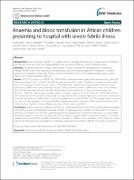| dc.description.abstract | Background: Severe anaemia in children is a leading cause of hospital admission and a major cause of mortality in
sub-Saharan Africa, yet there are limited published data on blood transfusion in this vulnerable group.
Methods: We present data from a large controlled trial of fluid resuscitation (Fluid Expansion As Supportive
Therapy (FEAST) trial) on the prevalence, clinical features, and transfusion management of anaemia in children
presenting to hospitals in three East African countries with serious febrile illness (predominantly malaria and/or
sepsis) and impaired peripheral perfusion.
Results: Of 3,170 children in the FEAST trial, 3,082 (97%) had baseline haemoglobin (Hb) measurement, 2,346/3,082
(76%) were anaemic (Hb <10 g/dL), and 33% severely anaemic (Hb <5 g/dL). Prevalence of severe anaemia varied
from 12% in Kenya to 41% in eastern Uganda. 1,387/3,082 (45%) children were transfused (81% within 8 hours).
Adherence to WHO transfusion guidelines was poor. Among severely anaemic children who were not transfused,
52% (54/103) died within 8 hours, and 90% of these deaths occurred within 2.5 hours of randomisation. By
24 hours, 128/1,002 (13%) severely anaemic children had died, compared to 36/501 (7%) and 71/843 (8%) of those
with moderate and mild anaemia, respectively. Among children without severe hypotension who were randomised
to receive fluid boluses of 0.9% saline or albumin, mortality was increased (10.6% and 10.5%, respectively) compared
to controls (7.2%), regardless of admission Hb level. Repeat transfusion varied from ≤2% in Kenya/Tanzania to 6 to
13% at the four Ugandan centres. Adverse reactions to blood were rare (0.4%).
Conclusions: Severe anaemia complicates one third of childhood admissions with serious febrile illness to hospitals
in East Africa, and is associated with increased mortality. A high proportion of deaths occurred within 2.5 hours of
admission, emphasizing the need for rapid recognition and prompt blood transfusion. Adherence to current WHO
transfusion guidelines was poor. The high rates of re-transfusion suggest that 20 mL/kg whole blood or 10 mL/kg
packed cells may undertreat a significant proportion of anaemic children. Future evaluation of the impact of a larger
volume of transfused blood and optimum transfusion management of children with Hb of <6 g/dL is warranted. | en_US |

